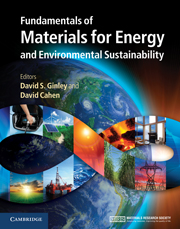Book contents
- Frontmatter
- Contents
- Contributors
- Preface
- Acknowledgments
- Part 1 Energy and the environment: the global landscape
- Part 2 Nonrenewable energy sources
- Part 3 Renewable energy sources
- 17 Solar energy overview
- 18 Direct solar energy conversion with photovoltaic devices
- 19 Future concepts for photovoltaic energy conversion
- 20 Concentrating and multijunction photovoltaics
- 21 Concentrating solar thermal power
- 22 Solar thermoelectrics: direct solar thermal energy conversion
- 23 Off-grid solar in the developing world
- 24 Principles of photosynthesis
- 25 Biofuels and biomaterials from microbes
- 26 Biofuels from cellulosic biomass via aqueous processing
- 27 Artificial photosynthesis for solar energy conversion
- 28 Engineering natural photosynthesis
- 29 Geothermal and ocean energy
- 30 Wind energy
- Part 4 Transportation
- Part 5 Energy efficiency
- Part 6 Energy storage, high-penetration renewables, and grid stabilization
- Summary
- Appendix A Thermodynamics
- Appendix B Electrochemistry
- Appendix C Units
- Index
- References
17 - Solar energy overview
from Part 3 - Renewable energy sources
Published online by Cambridge University Press: 05 June 2012
- Frontmatter
- Contents
- Contributors
- Preface
- Acknowledgments
- Part 1 Energy and the environment: the global landscape
- Part 2 Nonrenewable energy sources
- Part 3 Renewable energy sources
- 17 Solar energy overview
- 18 Direct solar energy conversion with photovoltaic devices
- 19 Future concepts for photovoltaic energy conversion
- 20 Concentrating and multijunction photovoltaics
- 21 Concentrating solar thermal power
- 22 Solar thermoelectrics: direct solar thermal energy conversion
- 23 Off-grid solar in the developing world
- 24 Principles of photosynthesis
- 25 Biofuels and biomaterials from microbes
- 26 Biofuels from cellulosic biomass via aqueous processing
- 27 Artificial photosynthesis for solar energy conversion
- 28 Engineering natural photosynthesis
- 29 Geothermal and ocean energy
- 30 Wind energy
- Part 4 Transportation
- Part 5 Energy efficiency
- Part 6 Energy storage, high-penetration renewables, and grid stabilization
- Summary
- Appendix A Thermodynamics
- Appendix B Electrochemistry
- Appendix C Units
- Index
- References
Summary
Focus
Utilization of solar energy on a terrawatt scale is a viable, environmentally conscious solution to the growing global demand for energy. Key solar technologies that can provide significant reductions in carbon emissions and environmental pollution, including conventional photovoltaics, concentrating photovoltaics, and solar thermal technologies, as well as passive solar technologies such as biofuels, biomass, and wind power, are highlighted here and discussed in detail in the following chapters.
Synopsis
As described in Chapter 3, energy, water, and food supply will all pose key challenges in the coming decades. Because of their ramifications in terms of socioeconomic development, quality of life, and political relations, these mounting concerns could result in more conflict and global instability if not addressed promptly and effectively. This chapter summarizes the contributions that active and passive solar energy technologies could make toward addressing this crisis. Solar energy is a viable solution to both energy demand and environmental issues; however, the mass deployment of some solar technologies faces some real challenges that are not necessarily only technological in nature but in many cases are also economic and sociopolitical. Today, coal, natural gas, oil derivatives, and nuclear energy are the most cost-effective routes to large-scale electricity generation. However, these traditional technologies have environmental impacts that, in some instances, have been catastrophic not only for the environment but also for the people and the economy of the areas affected (e.g., the Chernobyl nuclear disaster of 1986, the Gulf of Mexico oil spill of 2010).
- Type
- Chapter
- Information
- Publisher: Cambridge University PressPrint publication year: 2011
References
- 1
- Cited by



